Related Research Articles
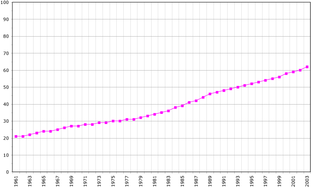
Demographics of American Samoa include population density, ethnicity, education level, health of the populace, economic status, religious affiliations and other aspects. American Samoa is an unincorporated territory of the United States located in the South Pacific Ocean.

The demographics of Guam details an array of demographic statistics relating to the territory of Guam. This includes statistics on population, including the Indigenous population; religious affiliations; language; and immigration. The Demographics of Guam provides an overview of the history of Guam, as well as a depiction of the villages in the United States territory and its populace. The population of Guam, as of July 2021 was 168,801.
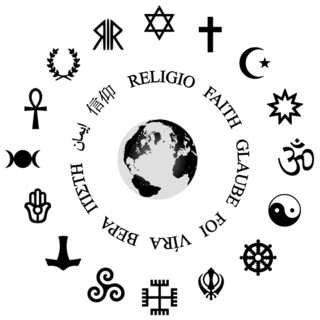
The following outline is provided as an overview of and topical guide to religion:

Religion in Japan is manifested primarily in Shinto and in Buddhism, the two main faiths, which Japanese people often practice simultaneously. According to estimates, as many as 80% of the populace follow Shinto rituals to some degree, worshiping ancestors and spirits at domestic altars and public shrines. An almost equally high number is reported as Buddhist. Syncretic combinations of both, known generally as shinbutsu-shūgō, are common; they represented Japan's dominant religion before the rise of State Shinto in the 19th century.
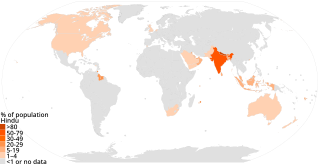
Hinduism has approximately 1.2 billion adherents worldwide. Hinduism is the third largest religion in the world behind Christianity (31.5%) and Islam (23.3%).
The Western religions are the religions that originated within Western culture, which are thus historically, culturally, and theologically distinct from Eastern, African and Iranian religions. The term Abrahamic religions is often used instead of using the East and West terminology, as these originated in the Middle East.
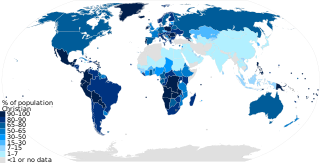
As of the year 2021, Christianity had approximately 2.38 billion adherents and is the largest religion by population respectively. According to a PEW estimation in 2020, Christians made up to 2.38 billion of the worldwide population of about 8 billion people. It represents nearly one-third of the world's population and is the largest religion in the world, with the three largest groups of Christians being the Catholic Church, Protestantism, and the Eastern Orthodox Church. The largest Christian denomination is the Catholic Church, with 1.3 billion baptized members. The second largest Christian branch is either Protestantism, or the Eastern Orthodox Church.

Religion has been a major influence on the societies, cultures, traditions, philosophies, artistic expressions and laws within present-day Europe. The largest religion in Europe is Christianity. However, irreligion and practical secularisation are also prominent in some countries. In Southeastern Europe, three countries have Muslim majorities, with Christianity being the second-largest religion in those countries. Ancient European religions included veneration for deities such as Zeus. Modern revival movements of these religions include Heathenism, Rodnovery, Romuva, Druidry, Wicca, and others. Smaller religions include Indian religions, Judaism, and some East Asian religions, which are found in their largest groups in Britain, France, and Kalmykia.
Asia is the largest and most populous continent and the birthplace of many religions including Buddhism, Christianity, Confucianism, Hinduism, Islam, Jainism, Judaism, Shinto, Sikhism, Taoism and Zoroastrianism. All major religious traditions are practiced in the region and new forms are constantly emerging. Asia is noted for its diversity of culture.
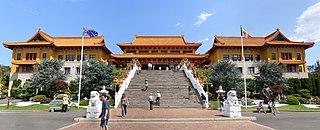
In Australia, Buddhism is a minority religion. According to the 2016 census, 2.4 percent of the total population of Australia identified as Buddhist. It was also the fastest-growing religion by percentage, having increased its number of adherents by 79 percent between the 1996 and 2001 censuses. The highest percentage of Buddhists in Australia is present in Christmas Island, where Buddhists constitute 18.1% of the total population according to the 2016 Census. Buddhism is the fourth largest religion in the country after Christianity, Islam and Hinduism.
Growth of religion involves the spread of individual religions and the increase in the numbers of religious adherents around the world. In sociology, desecularization is the proliferation or growth of religion, most commonly after a period of previous secularization. Statistics commonly measure the absolute number of adherents, the percentage of the absolute growth per-year, and the growth of converts in the world.
Christianity is the dominant religioninPalau, practiced by around 91.3% of the total population, according to the 2015 census. Freedom of religion is enshrined in Palau's constitution.

Buddhism is practised in Africa. Though there have been some conversions amongst Africans, the majority of Buddhists in Africa are of Asian descent, mostly Chinese, Vietnamese, Sri Lankan or Japanese.

Religion in South Korea is diverse. Most South Koreans have no religion. Christianity and Buddhism are the dominant confessions among those who affiliate with a formal religion. Buddhism, which arrived in Korea in 372 AD, has thousands of temples built across the country.
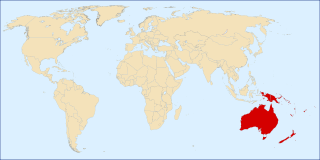
The following outline is provided as an overview and topical guide to Oceania.

Oceania is a region centered on the islands of the tropical Pacific Ocean. Conceptions of what constitutes Oceania vary, with it being defined in various ways, often geopolitically or geographically. In the geopolitical conception used by the United Nations, International Olympic Committee, and many atlases, the Oceanic region includes Australia and the nations of the Pacific from Papua New Guinea east, but not the Malay Archipelago or Indonesian New Guinea. The term is sometimes used more specifically to denote Australasia as a geographic continent, or biogeographically as a synonym for either the Australasian realm or the Oceanian realm.
The Baháʼí Faith is a minority religion in all the countries of Oceania. Baháʼí Houses of Worship are present in Australia, Samoa, and Vanuatu, and another is under construction in Papua New Guinea. Malietoa Tanumafili II of Samoa was a follower of the Baháʼí Faith and the first Baháʼí head of state.
Christianity is the dominant religion in Oceania with 65%.
References
- ↑ "2071.0 - Census of Population and Housing: Reflecting Australia - Stories from the Census, 2016". www.abs.gov.au. Archived from the original on 20 September 2017. Retrieved 13 January 2022.
- ↑ Australia. Bureau of Statistics. Year Book Australia, 2003. 21 January 2003. 19 May 2006.
- ↑ Table 28, 2013 Census Data – QuickStats About Culture and Identity – Tables.
- ↑ "Religions in Northern Mariana Islands - PEW-GRF". www.globalreligiousfutures.org. Archived from the original on 2019-04-21. Retrieved 2018-09-21.
- 1 2 3 International Religious Freedom Report 2007: Tonga. United States Bureau of Democracy, Human Rights and Labor (September 14, 2007). This article incorporates text from this source, which is in the public domain.
- ↑ "American Samoa: Adherents Profile at the Association of Religion Data Archives, World Christian Database". Thearda.com. Archived from the original on September 29, 2018. Retrieved February 26, 2014.
- ↑ Religion in Vanuatu
- ↑ Guam Archived 2017-09-12 at the Wayback Machine . www.globalreligiousfutures.org.
- ↑ "The Association of Religion Data Archives | National Profiles". Thearda.com. Archived from the original on 2013-10-02. Retrieved 2013-06-03.
- ↑ Willard Price. Japan's Islands of Mystery. p. 111.
- ↑ Brigham Young University—Hawaii Campus (1981), p. 36
- ↑ "Religious Adherents, 2010 (World Christian Database)". The Association of Religion Data Archives. Archived from the original on 23 June 2021. Retrieved 20 February 2016.